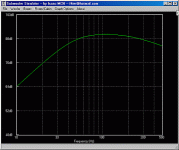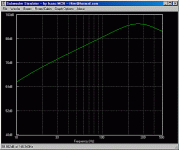I'm sure someone will correct me if I'm wrong (they'd better) but I don't see the relationship between the motor strength and the LF response as an independent parameter. LF has to do with air displacement which is a combination of surface area and excursion distance. I understand motor strength plays a part in this too. Oh, and let's not forget mass.
The higher the Bl, typically the lower the Qes, which does indeed tend to raise the 3dB point.
But that's nothing a little EQ can't fix. The real limit of woofer low frequency extension is the displacement, as mentioned above.
But that's nothing a little EQ can't fix. The real limit of woofer low frequency extension is the displacement, as mentioned above.
I'll use these as an example (just 'cuz I can grab the numbers quick).
The Adire AV8 has a BL of 9 and the Tempest has a BL of 14. I'm pretty sure the Tempest will go lower than the AV8.
The Adire AV8 has a BL of 9 and the Tempest has a BL of 14. I'm pretty sure the Tempest will go lower than the AV8.
Is it true that the higher the BL of a subwoofer, the higher its lowest playable frequerncy ?
no, it is not true.
😉 sreten.
Actually Fs stays the same but Qe (which is dominant usually) gets lower. So if in a closed box, low cut off rises.
But this is when other T/S parameters stay the same. You can not compare different speakers on BL alone.
😉
But this is when other T/S parameters stay the same. You can not compare different speakers on BL alone.
😉
HIGH Re GIVES HIGH BL WITH HI Qes
If you use a hig Re voice coil resistance, you can get high BL, and also high Qes.
With a 32 ohm Re you can achieve
Bl = 27
Qes=0.567
Fs=22 Hz
If you use a hig Re voice coil resistance, you can get high BL, and also high Qes.
With a 32 ohm Re you can achieve
Bl = 27
Qes=0.567
Fs=22 Hz
That would mean thin voice coil wiring, which would lower power handling, or a longer voice coil (more layers usually, I think), which would also lower power handling.
Right?
Right?
Actually, thin wire and/or a longer voice coil usually increases power handling (until you get so thin it can't handle the current).
For a given driver, if you raise the BL, you lose low end for a given box. Hoffman's Iron Law. Raising BL raises efficiency, meaning for a given box, you must lose low end extension.
EQ can make up for it, and ultimately - as RobM an Tim8ter point out - maximum SPL capability is displacement. But for small signal, non-boosted low end, you can have too much BL.
Dan Wiggins
Adire Audio
For a given driver, if you raise the BL, you lose low end for a given box. Hoffman's Iron Law. Raising BL raises efficiency, meaning for a given box, you must lose low end extension.
EQ can make up for it, and ultimately - as RobM an Tim8ter point out - maximum SPL capability is displacement. But for small signal, non-boosted low end, you can have too much BL.
Dan Wiggins
Adire Audio
Hi all:
New guy here.
It seems to me that Re is just an undesireable side effect of the voice coil conductor. Ideally, wouldn't a very low Re be desireable from an efficiency and power handling standpoint? All the motor cares about is Bli, and V is just a requirement to obtain i.
Also, does a high Bl lose low-end for a given box, or does it actually gain high-end since low-end is probably Xmax limited and high-end is efficiency (and inductance) limited?
I ask because I really don't know.
-Casey Walsh
New guy here.

It seems to me that Re is just an undesireable side effect of the voice coil conductor. Ideally, wouldn't a very low Re be desireable from an efficiency and power handling standpoint? All the motor cares about is Bli, and V is just a requirement to obtain i.
Also, does a high Bl lose low-end for a given box, or does it actually gain high-end since low-end is probably Xmax limited and high-end is efficiency (and inductance) limited?
I ask because I really don't know.

-Casey Walsh
Theoretically it's the high end gains output; efficiency of a driver really affects the passband of the system; down around the cutoff of the box, it is the box itself that dominates the efficiency.
Dan Wiggins
Adire Audio
Dan Wiggins
Adire Audio
SmarmyDog:
It is true that most of the electric power delivered to the driver is turned into heat in the voice coil, so lowering its resistance without changing anything else would increase the efficiency. However, the Qes and thereby the Qts value is determined by Qes=ws*Mms/Res, where Res=(Bl)^2/Re, so a low Re will decrease Qts. So lowering Re a lot would ultimately lead to a frequency response tilting by +6dB/octave instead of the flat response we want.
It is true that most of the electric power delivered to the driver is turned into heat in the voice coil, so lowering its resistance without changing anything else would increase the efficiency. However, the Qes and thereby the Qts value is determined by Qes=ws*Mms/Res, where Res=(Bl)^2/Re, so a low Re will decrease Qts. So lowering Re a lot would ultimately lead to a frequency response tilting by +6dB/octave instead of the flat response we want.
454Casull:
Here is a Peerless 850146 with no modifications. It is in a 56 liter box, sealed. The BL, (or Tm) is 10.0. Note the curve.
This simulation program is Subwoofer Simulator by our own F4ier. Unfortunately,this version of the program does not allow several size boxes of the same type to be modelled all at once, (or at least I don't know how to do it). But boy, this gives you all the curves, (impedance, impedance phase, cone excursion, port output, etc) that you can want, if you choose to select them.
http://www.geocities.com/f4ier/speaker.htm
The high frequency rolloff on this simulation assumes that inductance alone accounts for mid frquency behavior. As such, it is somewhat inaccurate. But you can ignore the mid frequency rolloff for our purposes.
Here is a Peerless 850146 with no modifications. It is in a 56 liter box, sealed. The BL, (or Tm) is 10.0. Note the curve.
This simulation program is Subwoofer Simulator by our own F4ier. Unfortunately,this version of the program does not allow several size boxes of the same type to be modelled all at once, (or at least I don't know how to do it). But boy, this gives you all the curves, (impedance, impedance phase, cone excursion, port output, etc) that you can want, if you choose to select them.
http://www.geocities.com/f4ier/speaker.htm
The high frequency rolloff on this simulation assumes that inductance alone accounts for mid frquency behavior. As such, it is somewhat inaccurate. But you can ignore the mid frequency rolloff for our purposes.
Attachments
Now here is the same speaker in the same 56 liter sealed box. Only this time, the BL, (Tm) rating is twice as high. From 10 to 20.
Note the midband sensitivity is increased, but the rolloff is quicker.
That is another way of saying that Qes, (and thereby Qts) is lowered dramatically.
Note the midband sensitivity is increased, but the rolloff is quicker.
That is another way of saying that Qes, (and thereby Qts) is lowered dramatically.
Attachments
Thanks for the quick, succinct replies! Funny, about an hour after I posted my questions, my copies of TLDC (Vance Dickason) and Testing Loudspeakers (Joe D'Appolito) arrived from PartsExpress. Hopefully I’ll post “deeper” questions after I get a chance to read these puppies.
-Casey Walsh
-Casey Walsh
- Status
- Not open for further replies.
- Home
- Loudspeakers
- Subwoofers
- Is it true that the higher the BL of a subwoofer, the higher its lowest playable...

